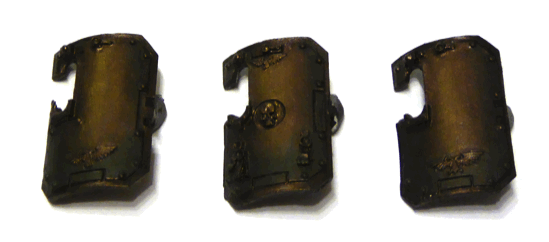Hi folks,
In two weeks time I will be wrapping up the Luthien campaign, along with my mate Wade, with one final apocalyptic showdown. This game was originally scheduled for the start of January but I was sick and missed the whole gaming day, much to my eternal shame. To get back into the swing of things, because we haven't played for a couple of months, we had a warm up slug-fest on Tuesday night.
For those of you who haven't played Battletech before, it is a game where you control one or more 20-100 ton Battlemechs in a game of armoured combat. You maneuver your forces by spending movement points (walking, running or, sometimes, jumping). Weapons have different special rules, maximum ranges and range increments, each causing a specific amount of damage and generating heat. Damage is dealt to random locations (usually) and recorded, along with heat, on a record sheet specific for your Mech.
 |
| My Highlander IIC taking a pounding to the left torso. |
Once you have stripped the armour off your enemy, you can start hitting critical locations of the internal structure, including weapons, articulating joints, engine, gyroscope and ammunition stores. The temptation is to go all-out with your weapons ("an alpha strike"), but heat management is vital. I have shot many Mechs to pieces after they shut down due to over-zealous shooting phases.
We both took some heavy hitters for this game; I had a Timberwolf Primary (75 tons), which is a long range laser and missile platform, and a Highlander IIC (90 tons), which can snipe with its Gauss rifle/missiles at long range but also has a close range brawler's load out.
 |
| Highlander IIC and Timberwolf Primary |
Wade took a Warhawk Primary (85 tons), which is a long range particle cannon spam can, and a Warhammer IIC (80 tons), which adds
another two particle cannons to the mix, but also excels as a close range brawler. Particle projector cannons (PPCs) are the most powerful energy weapons in the tech level Wade and I usually play, but also produce the most heat when fired. Wade had
6 of the damn things.
 |
| Clockwise from left: Warhammer IIC, Warhawk Primary, Highlander IIC and Timberwolf Primary |
Early on in the game I tried to use the depth of the canyon to hide from the Warhawk whilst focusing fire on the Warhammer IIC. I was able to do a lot of damage this way, but lost a few crucial initiative rolls. This allowed Wade to see my movements
before he moved his last Mech. The Warhawk was maneuvered perfectly and combined fire with the Warhammer IIC to destroy my Timberwolf's right torso, stripping it of half its weapons. I was forced to present a target (my Highlander IIC) to the Warhawk, whilst backing my Timberwolf away to remove it from pulse laser range. After disabling some of the Warhammer IIC's weapons from long range, I charged in again with the half-a-Timberwolf and finished it off by hitting an ammunition magazine. The resulting explosion caused enough damage to remove it from the game. Exposed, the Highlander IIC took a pounding to one torso. Wade seems to randomly drill locations over and over again in a very non-random seeming way! With the Warhammer IIC out of the equation I turned both of my Mechs towards the essentially pristine Warhawk. Taking it down without losing one or both of my Mechs was going to take a lot of luck.
 |
2 vs 1. Well... actually... it was more like 0.9 vs 1 by this stage. Both of
my Mechs were being held together by happy thoughts alone. |
I hid my Timberwolf for a turn, as I felt that it only had one turn of punishment left in it and I wanted to make it count. I predicted that the Warhawk had three turns of fight in it, unless some fluky shot tipped the balance. The Timberwolf bolted out of cover and nailed the Warhawk with some shots, managing a lucky gyro hit (two of those will drop a Mech). The Highlander IIC dealt a hideous amount of damage up close, causing two engine hits (three of those will drop a Mech). Intending to finish the game there and then, Wade unleashed the Warhawk's entire arsenal on both Mechs, splitting his fire. The Highlander was hit by two PPCs but survived. One of the shots on the Timberwolf missed, so it also barely survived. The heat produced, however, caused the Warhawk to shutdown and its ammunition to cook off. The neural feedback to the pilot knocked him unconscious, which, combined with the lucky gyro hit, caused the heavy Mech to fall over.
Prone, unconscious and shut down: excellent.
 |
| There can be only 1! Well... actually... it was more like 0.45 by this stage. |
The next turn, I moved the Highander IIC into position and unleashed hell. The Warhawk never got back up.
The final result did not reflect how close the game was; my Mechs were both severely damaged by the end and just one hit away from the grave. It was very cathartic to get a game in after such a dry spell and the disappointment of prior missed opportunities.
If our gaming history has proven anything, Wade will be swinging the victory bat next game, which will make for a challenging end to our Luthien campaign.
See you across the table,
M4cr0






























